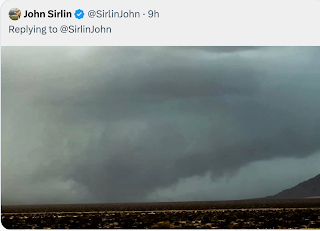What Is It Like to Be a Meteorologist On Camera During a Major Tornado Outbreak?
Two words: Incredibly stressful.
Twenty-three years ago today I was in that position. I was doing television on KSNW TV during the Kansas-Oklahoma tornado outbreak of April 26, 1991.
The worst tornado was the one that went through south Wichita and Andover which killed 17 people. Here is a video of the tornado with the audio from KWCH TV in the background. You can hear Merril Teller urging people to take shelter, giving tornado safety rules and explaining the tornadoes (yes, there were two in Sedgwick Co. simultaneously plus a third developing along the Kansas-Oklahoma border in our viewing area) locations and movements. This was before Doppler radar was available, yet television meteorologists did a superb job tracking the storms.
The Centers for Disease Control did a study and determined the warnings saved about 75 lives in that tornado alone.
Later this weekend, television meteorologists will on the air, perhaps throughout the night, keeping people informed and saving lives. Please reach out to their stations and let them know you appreciate their efforts.
Twenty-three years ago today I was in that position. I was doing television on KSNW TV during the Kansas-Oklahoma tornado outbreak of April 26, 1991.
The worst tornado was the one that went through south Wichita and Andover which killed 17 people. Here is a video of the tornado with the audio from KWCH TV in the background. You can hear Merril Teller urging people to take shelter, giving tornado safety rules and explaining the tornadoes (yes, there were two in Sedgwick Co. simultaneously plus a third developing along the Kansas-Oklahoma border in our viewing area) locations and movements. This was before Doppler radar was available, yet television meteorologists did a superb job tracking the storms.
The Centers for Disease Control did a study and determined the warnings saved about 75 lives in that tornado alone.
Later this weekend, television meteorologists will on the air, perhaps throughout the night, keeping people informed and saving lives. Please reach out to their stations and let them know you appreciate their efforts.





I just found a video on youtube of your reporting on this storm in 1991. I can't believe it wasn't wall-to-wall coverage. Wow how things have changed on local news channels. You mentioned going to commercials at one point and it seems like NBC prime time national programming was carried during a lot of this storm. Down here in Oklahoma, this would never happen now. I just wonder if there was more push to not interrupt programming back then.
ReplyDeleteExcellent question: In 1991, the networks paid their local affiliates (NBC in this case) huge amounts of money to run their programs and the commercial embedded therein.
ReplyDeleteThat all changed about ten years ago. Now, the networks pay nothing and, in some cases, the local affiliates have to pay the networks. So, wall-to-wall coverage doesn't cost the station.
There was a huge financial loss to the stations in 1991 for as many interruptions as we did that evening, interruptions that lasted as many as ten minutes at a time. You have to remember that we did not have the degree of automation that TV meteorologists enjoy today. With everything having to be done manually, we had to go off air every few minutes to get the latest information.
Thanks for asking.